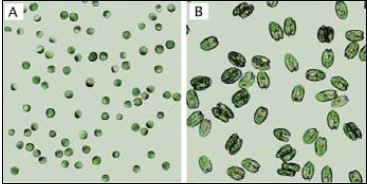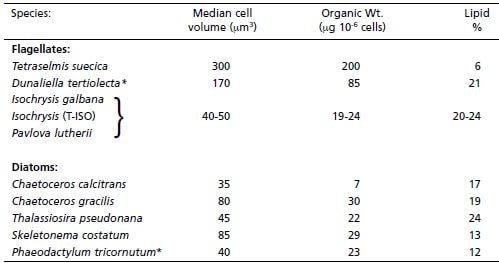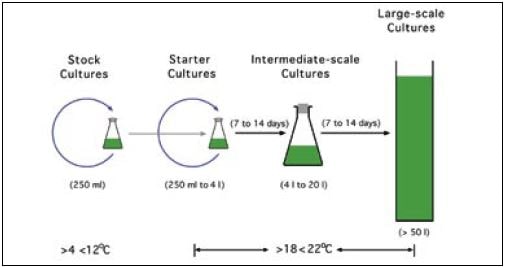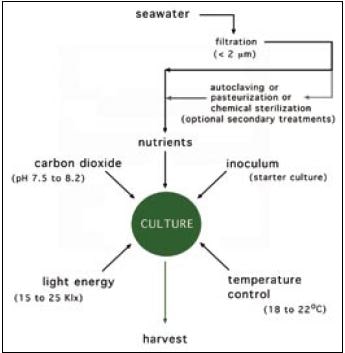3.1 INTRODUCTION
Unicellular marine microalgae (Figure 12) are grown as food for the various stages in the hatchery culture of commercially valuable shellfish. Until recently living algae constituted the sole food source for bivalve larvae and juveniles. This is now beginning to change as the result of recent research into the development of suitable non-living

Figure 12:
P h o t o m i c r o g r a p h s of two algal species commonly cultured in hatcheries, Isochrysis sp.
(A) and Tetraselmis sp.
(B) showing the relative difference in cell size.
and artificial diets. However, the production of live algae will remain a critically important aspect of successful hatchery management into the foreseeable future, if only as a live food supplement to innovative foodstuffs.
Flagellate and diatom species, among the microalgae, are primary producers at the base of the marine food chain. They manufacture organic cellular components from the uptake of carbon dioxide and nutrients contained in seawater using light as the energy source in a process called photosynthesis. They are normally cultured in hatcheries in suitably treated natural seawater enriched with additional nutrients, which include nitrates, phosphates, essential trace elements, vitamins and carbon dioxide as the carbon source. Synthetic seawater may be used but it is prohibitively expensive except at the small laboratory scale.
The need to culture microalgae arises because the natural phytoplankton content of seawater used in the hatchery is insufficient to support optimum growth of high densities of larvae and juveniles reared. Particularly in the culture of larvae, the water treatments used will remove almost all of the natural phytoplankton which then needs to be replaced from cultures of preferred, high food value species. In this context, and in the provision of suitable food rations for breeding stock and juveniles, few of the very many naturally occurring algae are of good food value to bivalves and not all of these are amenable to artificial culture on a sufficiently large scale. A list of the more commonly used species in bivalve hatcheries is given in Table 1. Parameters of cell size and composition are also shown.
Table 1: The cell volume, organic weight and gross lipid content of some of the more commonly cultured algal species used as foods for bivalve larvae and spat. Species marked * are of relatively poor nutritional value.

The culture of algae accounts for about 40% of the costs of rearing bivalve seed to a shell length of about 5 mm in a hatchery. For example, 1 million juvenile Manila clams or Pacific oysters of 5 mm shell length will consume 1 400 l of high density, cultured algae each day at the optimum rearing temperature of 24°C. Smaller daily volumes are required to feed broodstock and larvae.
The basic methods of algal culture have changed little over the years and the various steps in the process leading to production-scale cultures are introduced in Figure 13. Hatcheries have either opted for indoor, intensive culture with artificial illumination, usually external to the culture vessels, or outdoor, extensive culture in large tanks

Figure 13: Steps in the production of algae. Stock cultures (250 ml or less) remain in isolation under light and climate control (low temperature) and are only used to inoculate starter cultures when necessary. They are not aerated nor is carbon dioxide added. Starter cultures (250 ml to 4 l in volume) are grown quickly for 7 to 14 days at higher temperatures and light intensity with a supply of carbon dioxide enriched air. When ready, a small portion of the volume is used to start a new starter culture and the main portion to begin an intermediate-scale culture. Intermediate
scale cultures (usually of between 4 l and 20 l in volume) may be used as food for larvae or to start a large-scale culture. Large-scale cultures are generally of a minimum of 50 l and are frequently much greater in volume.
or ponds utilizing natural light. The intensive techniques are satisfactory in terms of reliability and productivity but are expensive in terms of capital outlay and labour, while the extensive methods tend to be less reliable and, sometimes not very productive. Both methods will be considered together with the essential infrastructure and methodologies. A schematic diagram of the process of culturing algae is given in Figure 14 and a floor plan of a hatchery showing the area allocated to algal culture was given earlier in Figure 5 (section 1.2).

Figure 14: The process of algal culture showing the various required inputs.
Whether secondary seawater treatment is necessary or not depends on the extent to which the water is initially filtered.